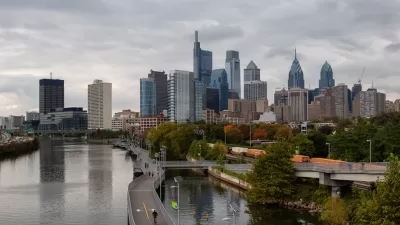Several highway-widening projects on the East Coast were approved under the pretense of expected growth in traffic totals. Now planners are scrambling to figure out the new normal.

“Highway planners misjudged the future because the Great Recession reduced both commercial and passenger travel, and because of an unexpected drop in driving by young adults,” writes Paul Nussbaum.
The article includes a lengthy list of highway projects that moved forward based on projections that now look anything but clairvoyant.
- For the $2.5 billion project to widen the New Jersey Turnpike, the planners estimated that northbound traffic volume would increase by nearly 68 percent above 2005 levels and southbound traffic would increase by 92 percent by 2032. Quite the opposite trend has taken place: “Now, one-third of the way through that 27-year forecast, turnpike traffic is actually about 10 percent lower than it was in 2005.”
- “In 2007, the Pennsylvania Turnpike Commission assumed that traffic would grow 3 percent to 5 percent every year to help pay for debt as it took on a new obligation to contribute up to $900 million a year to fix other roads around the state.” Instead, “traffic has been essentially flat.”
- “And when the Delaware River Joint Toll Bridge Commission decided in 2003 to replace the 50-year-old, four-lane Scudder Falls Bridge on I-95 with a $328 million, nine-lane, 180-foot-wide toll bridge, it assumed that traffic would increase 35 percent by 2030.” Rather, “bridge traffic has declined slightly and is now below the levels of 2002.”
- The Schuylkill Expressway and Interstates 95 and 476 have also experienced reductions in traffic over the last six years.
FULL STORY: Drop in traffic on area highways forces review of plans

Maui's Vacation Rental Debate Turns Ugly
Verbal attacks, misinformation campaigns and fistfights plague a high-stakes debate to convert thousands of vacation rentals into long-term housing.

Planetizen Federal Action Tracker
A weekly monitor of how Trump’s orders and actions are impacting planners and planning in America.

In Urban Planning, AI Prompting Could be the New Design Thinking
Creativity has long been key to great urban design. What if we see AI as our new creative partner?

King County Supportive Housing Program Offers Hope for Unhoused Residents
The county is taking a ‘Housing First’ approach that prioritizes getting people into housing, then offering wraparound supportive services.

Researchers Use AI to Get Clearer Picture of US Housing
Analysts are using artificial intelligence to supercharge their research by allowing them to comb through data faster. Though these AI tools can be error prone, they save time and housing researchers are optimistic about the future.

Making Shared Micromobility More Inclusive
Cities and shared mobility system operators can do more to include people with disabilities in planning and operations, per a new report.
Urban Design for Planners 1: Software Tools
This six-course series explores essential urban design concepts using open source software and equips planners with the tools they need to participate fully in the urban design process.
Planning for Universal Design
Learn the tools for implementing Universal Design in planning regulations.
planning NEXT
Appalachian Highlands Housing Partners
Mpact (founded as Rail~Volution)
City of Camden Redevelopment Agency
City of Astoria
City of Portland
City of Laramie





























